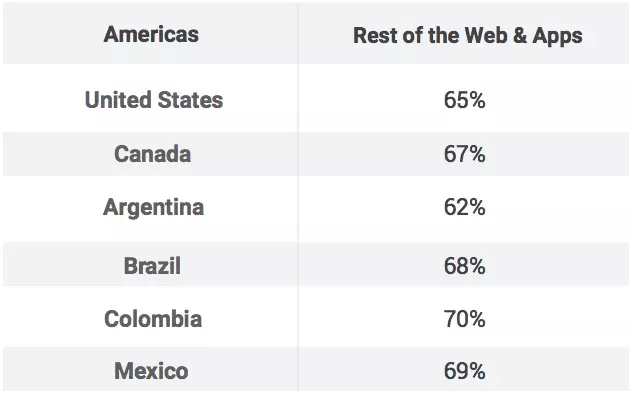In 2011, IAB, 4As, and ANA came together to form an initiative called “Making Measurement Make Sense (3MS),” whose first goal is to define ad impressions and viewability.
Ad impressions and viewability have now become crucial factors determining the success of online ad campaigns. However, how to improve ad viewability remains a question.

As a publisher, ad viewability directly impacts your bottom line. No one wants to pay for non-viewable impressions. Everyone, from SSPs to DSPs to Advertisers, wants to know your inventories’ viewability.
Ultimately, increasing the viewability is on your plate. Considering the rise of vCPM (viewable CPM where advertisers have the leverage to pay only for ad impressions deemed viewable as per the MRC viewability standard), we don’t have a choice.
So, here’s a definite guide to identifying and optimizing the factors affecting ad viewability.
Table of Contents
What Is Ad Viewability?
Ad viewability is a metric in digital advertising that measures how visible the ads are on the publisher’s website(Desktop or mobile). Simply, it counts the impressions that are seen.
The ads at the top of the page usually have high ad viewability as they stay in view as soon as the page loads. The ads on the bottom page will get views only when the user scrolls down. Buyers demand the ad inventory with high viewability as it increases the chances of their ad being seen.
How It All Started?
Before we dive into the blog’s theme, let us see how ad viewability entered adtech.
Advertisers (to say most of them) calculate their ad spending based on the impressions delivered by the publishers. So, when page loads and ads are rendered as they are meant to be, an impression is counted. Advertisers have to pay for it.
But wait, what if the ads are below the fold, and the user doesn’t care to scroll down the page? As you know, unseen advertisements don’t deliver results, which, in turn, impacts the ROI (Return on Investment). Then, the digital advertising ecosystem devised a solution called ‘Viewability.’
What Constitutes a View?
As per the Media Rate Council (MRA) and Internet Advertising Board (IAB) viewable impression guidelines:
- A display ad (image) is considered viewable when 50% of the ad is in the user’s view for one second.
- A video ad is considered viewable if 50% of the ad is in the user’s view for over two seconds.
- A larger ad format with over 250k pixels is considered viewable if 30% of the ad is in the user’s view for more than one second.
If an ad impression passes these criteria, it is considered a viewable impression.
Note: The MRC plans to shift the viewability standards to 100 percent pixels. Here’s the full story.
Why Is Ad Viewability Important for Publishers?
It’s quite obvious, isn’t it?
Advertisers won’t be interested in placing ads in the inventory with a poor viewability rate. To be frank, programmatic advertising has improved drastically from the stage where publishers can sell inventories based on impressions. Now, it’s a combination of several factors, and ad viewability is an essential one.
What Is an Ideal Ad Viewability Rate?
According to Amazon DSP, ads with 70% or higher viewability perform well and generate higher ROI than ads below the threshold. However, the ad with a viewability rate between 20 and 30% is also successful. From this, we can infer that above 70% is an ideal rate, but the campaign’s success depends on the advertiser’s expectations.
The ad unit with an ideal viewability rate attracts higher CPM demands than those below the threshold. But it doesn’t mean that the advertiser always wants ad units with higher viewability; they might need the ad unit with a 20 to 30% rate if they expect a space on a though-leader website at a low budget.
What Affects Ad Viewability? Factors to Consider
Many factors impact your ad viewability, and it isn’t possible to leave any of them to solve the viewability equation. That being said, sustaining the best practices is quite easy once you finish the initial groundwork.
Ad sizes
Based on the study by Google, the size of the ads has a severe influence on viewability. The research shows that the most viewable ad size is the vertical unit.
Most viewable ad units
| Ad Type | Ad Sizes |
| Horizontal | 234 x 60 |
| Vertical | 120 x 240 |
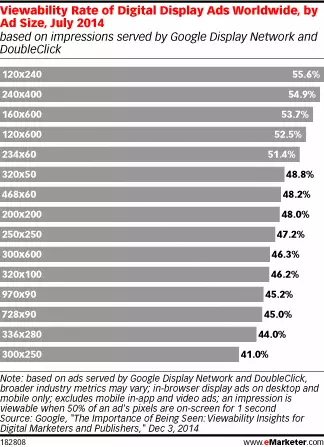
It is worth noting that larger ad units have higher CTR but not viewability. It reflects the clicks may be accidental as they cover the full screen and annoy users.
So, design and place your ad units accordingly. Also, we’ve created the best mobile ad sizes list for your reference.
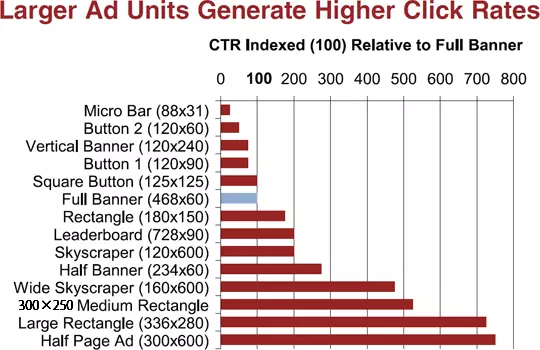
Geo
Here are the average ad viewability rates of video ads across various geos. How to use this?
Consider this a benchmark, and try to keep your average viewability above the numbers. Because advertisers tend to buy the impressions with the best viewability in specific geo, even if the buyer bids for all the viewable impressions (> 50% of ads are in view), DSPs can weed out the rest from the best.
Page arrangement
Ads placed exactly above the fold are largely viewable, while those at the top of the page have less viewability.
Having said this, ads above the fold have a median viewability of 68%, and those below the fold have an average viewability of 40%. We do insist on not taking this metric so seriously. Why? If your content engages, users will eventually scroll down to read more. Hence, below the fold ads might get almost the same viewability percentage as above the fold ads.
Engaging your users will better your domain’s viewability than switching between above the fold and below the fold.
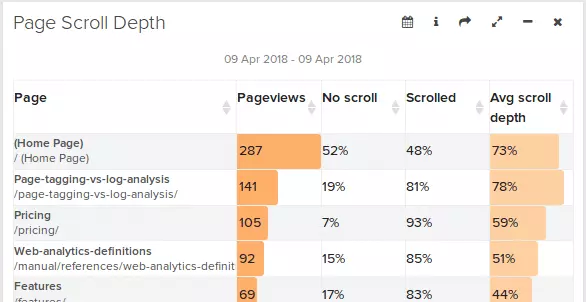
If the user tends to scroll more and reach 80% of the page, you don’t want to clutter your above the fold with ads. Disperse your ad units throughout the page based on engagement metrics.
Page length
Research says the shorter the content, the higher the viewability. A single-fold page makes it easy for users to get through content effortlessly.
But that doesn’t mean you should write short-form content. Your readers and the topic should always decide the page length.
Industry
There is a noteworthy difference in viewability across different industries. Websites with additional captive content have the highest viewability. Reference sites have the highest viewability of 51.9%, followed by online communities with 48.9% viewability.
The Arts & Entertainment industry has an average viewability of 48%.
Responsive design
Good user experience is created by developing responsive ads. Receptiveness ensures that ads are browser- and device-compatible, making them convenient for viewers and bettering ads’ viewability and returns for your business.
Page design
Page design is yet another major factor playing a crucial role in your ad viewability. Following a good design, the standard can help you with viewability. For instance, a streamlined page frame with fresh and clean design visuals makes a page pleasing with enhanced viewability.
Readers tend to delve in, and placing the ads along with the other content will improve viewability drastically.
Loading speed
Naturally, a website with ads from different ad networks is coupled with high load time. Because of poor load time, the users tend to get away from the website without even viewing the content; then, where’s the possibility of ads being shown?
Thus, it is important to speed up your page and ad load times to improve viewability. Here are a few techniques to improve the load speed of the ad/ page.
- Get rid of passback and implement header bidding in the right way.
- Position the ads in parallel with the page content
- Execute smart/asynchronous loading for ad units
- Enable lazy loading.
Stickiness
Nowadays, publishers are repeatedly interested in employing a fixed placement or position so that the ads can stay within a selected page area even when the user scrolls down the page. This implementation or method is known as Sticky Ads.

But, we advise you to be wary of the number of sticky ad units as it drowns the user experience (and Chrome hates it).
Sidebar
If you want an enhanced user experience and increased viewability, go for a sidebar layout. As the sidebar is always in view, you can easily place ad units, yielding higher eCPM and providing a seamless experience to the reader.
Here’s how The Washington Post runs ads on its sidebar.

Number of ads
Don’t increase the number of ad units to improve revenue. You might end up doing the opposite.
Why? Your users are here for the content, not for the ads. Interfering ads and pop-ups are always irritating because they compel them to take actions that may be irrelevant at the time. We advise enabling ad refresh, which scans multiple data points and refreshes the ad properly.
Referral traffic
Referral traffic is yet another affecting factor in increasing ad viewability. You’ll probably have many traffic acquisition channels and Point-of-Acquisitions (POAs) to guide the marketers.
We’re not asking you to change your acquisition channels but consider tweaking the ad units based on the referral. For instance, Google typically sends users looking for a particular piece of information. This means they’ll stay longer.
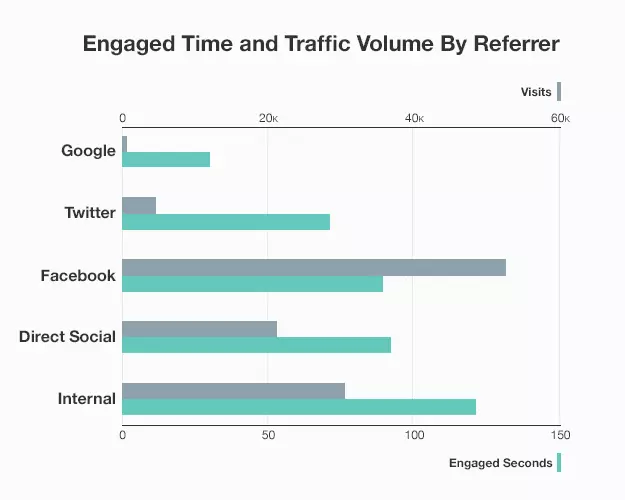
What can you do with this?
First, segment the pages that get most of the traffic from Google and try to append ad units below the fold or at the end of the article.
How to Increase Ad Viewability?
All the above factors are vital for better ad viewability and higher CPMs. As the one who’s done it for many publishers, we assure you that optimizing the abovementioned factors will yield impressive results. However, you should also consider following the best practices to maintain higher ad viewability.
- Utilizing the above-the-fold to display premium ads is ideal. However, the region in your website that gets the most visibility differs in content popularity. So, use heatmap tools to find the space with high viewability on every website page and place ad units accordingly.
- Scrutinize every page element to look for improvements in ads. You can build the masthead slightly lean or trim down the space occupied by your videos.
- Don’t backload your ads until they’ve been pulled into view by the users. This is called lazy loading. This method allows you to progress their ad viewability score and page load time.
- Implement advanced ad refresh. i.e., refresh based on ad viewability and user engagement on the page. Why? Viewability can increase by up to 50%.
- Experiment with various ad sizes and look for the best one. Although it is mentioned above that vertical ad sizes (especially 120 x 240 units) achieve the best results in general, you may want to spot which size fits your users*.
*Don’t keep changing the units in a few days. Most of the demands may take a week to analyze and act accordingly.
-
- Keep maintaining and improving your page design to lessen page load time. This will assist you in gaining better ad viewability and guarantee better performance across every facet.
- Use native ads because they gel with the content and don’t give the feel they are ads. Thus, it is a perfect way to improve ad viewability. Advertisers also prefer native ads since they have a high CTR and drive high traffic to the website.
- Optimize your header bidding stack; use a server-side header bidding solution to reduce page loading time, improving UX and increasing viewability.
- Follow industry standards like Acceptable Ads and Better Ad Standards to maintain good UX, which drives traffic and increases the ad viewability rate.
- Cross-domain iframes are problematic as they block crucial information such as URLs, texts, and geometric values of the ad creative element. IAB introduced SafeFrame, which allows secured data collection, proper viewability measurement, and programmatical transaction of rich media ads.
Ad Viewability Best Practices for Compliance
Collaborate with advertisers: As a publisher, you can get many insights from working with advertisers. You can optimize ad placement, size, and format and align their ad creative according to their campaign goals. This will increase ad viewability and strong partnerships.
Detailed dashboard and consistent monitoring: You need to set up a detailed dashboard that measures viewability and consistently monitors performance. This will help you make adjustments abruptly according to trends and stay proactive to maintain a good viewability rate.
Consistent testing and optimization: Testing different combinations and making adjustments is essential to increasing your viewability rate. It allows you to adapt to dynamic market changes and keeps you ahead of the curve.
What’s Next?
Some of the important trends in the industry, such as SSL, ad blocking, HTML5/Flash, Google AMP, etc, can seriously affect viewability. Thus, making viewability reporting, optimization, and benchmarking a part of your ad strategy is pivotal.
It is also necessary that publishers with low viewability invest time, perhaps by redesigning their websites to improve ad viewability.
Always have an action plan in place to monitor the factors and start working on boosting ad viewability. Need personalized recommendations? Reach out to us. And get connected with the best adtech monetization partner who offers customized solutions to boost ad viewability and, therefore, ad revenue.



